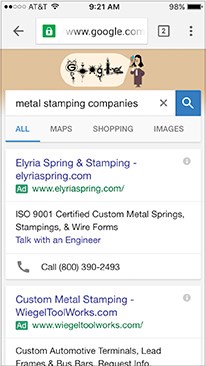Why Three Huge Google Changes Should Make You Reconsider Print Ads
With all the changes Google is making, relying on SEO as your prime lead generation tactic can become a scary proposition. To ensure you build brand awareness and inquiries across multiple channels, it pays to have a diverse marketing mix, one that includes print ads.
By Dianna Huff
www.twitter.com/diannahuff
Founder and President
Huff Industrial Marketing, Inc.

When Google’s search engine became the defacto way to find products and services online, it made sense that companies large and small shifted their marketing dollars away from print advertising and into search engine optimization (SEO).
Compared to print ads, SEO seemed to offer so many benefits, not the least of which you could reach far more buyers with a lot less money. Maybe you paid an SEO firm to help optimize your website, but you didn’t have to pay (or continue to pay) to get listed in Google’s organic (or non-paid) search results.
But . . . recent changes by Google have made SEO much more difficult. In fact, Google has made so many changes, I now tell clients that if they’re relying on SEO to generate the bulk of inquiries, they may want to reconsider their strategy.
Reason #1: Organic Search Is Delivering Diminishing Returns

But it doesn’t stop there. Google will sometimes insert a map pack right after the ads, which means the first organic (or “free”) listing is pushed even further down -- and we’re talking way down, as you can see in this image.
As expected, organic click-through rates (CTR) have dropped.
Acquisio, an agency specializing in programmatic marketing, analyzed data from across 90,000 pay-per-click (PPC) campaigns running on its platform. The company analyzed data four weeks before the AdWords change and two weeks after. The data showed:
- Impressions and clicks below the top 4 ads dropped significantly
- CPC (cost per click) for spots below the Top 4 ads increased
- CPC for ads in the Top 4 ads increased by as much as 10.5%
- CTR for ads in the Top 4 ads increased by as much as 4.5%
In other words, whether you rely on SEO or pay-per-click (or a combination of both), clicks are costing more money.
Google search result page
In addition to moving the text ads to the top of the SERP, Google has been making all kinds of other changes, such as expanding the white space between the ads. It’s also changed the standard text ad from a 25 character count headline and two lines of descriptive copy to expanded ads that include two headlines. On desktop, these two headlines become one long headline; on mobile, they wrap to become two headlines.
Then add in site links, video, or other text ad extensions -- and it’s pretty clear that organic is taking yet another hit in terms of lower clicks and being moved further down on the page.
All of this information is for desktop search -- for mobile, these changes mean that searchers often have to “swipe” their screens two or three times before they see organic results as Google’s text ads now take up the entire first screen. (See image below)

Speaking of mobile, Google houses its vast search engine data in multiple indexes, with mobile and desktop being the two primary ones. When you search for information using your smartphone, Google presents you with search results using its mobile index. Ditto for desktop searches.
Desktop search continues to drive the bulk of organic traffic for small industrial manufacturers. Mobile use is growing, but it represents only a fraction of traffic.
For the rest of the online marketplace, however, mobile is huge -- and Google has responded accordingly. In mid-October, the company announced its mobile index will become the primary index. Google has indicated this change will impact those businesses with mobile-versions of their website.
Again, this is another change that will impact SEO efforts – especially if your website is old, clunky, and not suited to the new mobile landscape.
(If you have responsive, or mobile-friendly, website that looks good on all browsers, then you’re fine. In fact, Google recommends you have this type of website versus a separate mobile site.)
Reason #3: Google Removed Search Volume Data from the Keyword Planning Tool
Print ads and SEO do have one thing in common: you can target a specific audience. With print ads, you can target specific industries and audiences based on the publication and its demographics.
With SEO, you can optimize your website or web pages using keywords that your target audience uses to find the products and services you offer. Except, not any more.
In June, Google made a huge change to its Keyword Planning Tool, namely, it removed search volume data -- the very data many SEOers use to help optimize a website. Google is recommending you use its forecasting tool instead.
What this change means is that it’s become much harder to know with precision which keywords to use when optimizing a website or web page. And, even with Search Console search query data, many small industrial manufacturers still don’t have a clue due to Google’s “Not Provided” or “Not Set” -- meaning, Google doesn’t pass search query information when a user is logged in and doing a search. Oy!
The Upshot? SEO Is No Longer the Silver Bullet
While SEO has been a boon for many manufacturers, especially smaller companies, it also comes with serious cost concerns and challenges. One, you have no idea when or how the game will change. What worked yesterday can now cause a serious penalty or outright ban from the Google search engine today.
And, because the search engine is constantly changing -- both in terms of its format and algorithm plus new content constantly being added to its indexes -- you can work for months to improve your “ranking” but see little in the way of results.
Print Ads Build Brand Awareness in a Way SEO Can’t
Despite the toll print ads have taken because of search, they’re still a worthwhile investment for small industrial manufacturers.
According to research by Gardner Business Media, manufacturers and engineers turn to trade publications to find information -- with 86% ranking print publications their number one and number two choice in terms of effectiveness.
While pursuing case studies, application notes, and other timely information, readers also see ads; since these ads could be from companies that they don’t know about or haven’t done business with, print ads help build brand awareness.

But print ads play another important role as well. According to Gardner’s survey data, 93% of buyers will click on companies whose name they recognize in the search results -- names searchers have seen as they read print publications.
With SEO, searchers have to know your brand or product / service exists. With print ads, your message is right there in front of them.
Print Ads Put You Back in Control
Once you sign a contract to run an ad multiple times during the year, you won’t have to worry about prices going up (even if the publication changes its format) or running afoul of any “rules” and getting penalized.
You also have some control over the placement of your ad. You can purchase high profile positions, such as the inside back cover, or any size ad that suits your budget. You can’t do that with SEO.
In Conclusion . . .
With all the changes Google is making, relying on SEO as your prime lead generation tactic can become a scary proposition. To ensure you build brand awareness and inquiries across multiple channels, it pays to have a diverse marketing mix, one that includes print ads.
Need more information?
Dianna Huff info@diannahuff.com
www.twitter.com/diannahuff
Founder and President
Huff Industrial Marketing, Inc.
37 Plaistow Road, Unit 7-245
Plaistow, NH 03865
603-382-8093
Fax: 603-382-1818

RELATED CONTENT
-
Your Media Representative – Feel the Love
Thank goodness I was taught to have a different attitude about space reps at my very first agency job out of college. Here are just some of the many things I’ve learned – and am still learning – from media representatives during my career in manufacturing marketing communications.
-
Media Solutions to Provide Direct Reach to Markets Served
As Account Manager in Sales serving the industrial audience with the latest informational content regarding the ever changing trends, Maalik Bomar plans to continue forward providing the best customer service to those client professionals seeking a direct reach to their markets served.
-
Drive More Web Traffic from Social Media
These helpful social media tactics can drive more traffic to your site. If you’re consistent in your efforts, you eventually will start noticing results. How can you reap the web traffic benefit and more? Here are nine ways to help.

